The term “screwdriver” is common in home improvement, but asking for one isn’t as simple as it used to be due to the many types available today.
Screws have evolved from simple slotted heads to complex security designs that require specific screwdrivers for removal.
As screws have become more specialised, so have screwdrivers. Without the right screwdriver head, driving in a screw is impossible. If you’re wondering whether the screwdriver or screw came first, there’s no clear answer yet.
It’s likely that as new screwdrivers were developed, matching screws or fasteners were created simultaneously, as they are mutually dependent.
The Screw Determines the Screwdriver
Below is a comprehensive list of screwdriver types. If you know of others, feel free to contact us.
Your choice of screwdriver depends on the screw you’re using. For more details, visit our screw types guide.
What Different Types of Screwdriver are There?
The list below comprises of the most commonly used types of screwdriver today, however there are a few select other, more unique types around and we have included these later in the project.
Slotted or Flat Blade Screwdriver
The slotted, or flat, screwdriver is the original and most basic type. It fits into the single slot on a screw head and comes in various sizes, from tiny precision tools to large industrial ones. For most DIYers, the common sizes are 5.5mm and 8mm wide.
Be cautious when using a slotted screwdriver. If pressure isn’t applied directly down the screw’s length, the tool can slip, potentially damaging your work or causing injury.

Slotted screwdrivers come in various sizes.
Traditional cabinet makers and joiners favour slotted screws for their neat appearance, often aligning slots for a polished finish. Some insist on perfectly aligned slots in hinges, showcasing craftsmanship and attention to detail.
If you use slotted screws, avoid power drivers. These screws aren’t designed for high torque, and using a drill-driver can damage the slot, making the screw difficult to insert or remove.
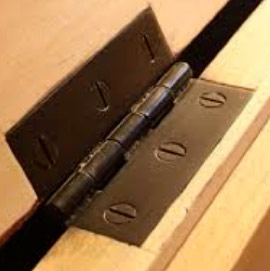
All slotted screw heads lined up in a row – Image courtesy of popularwoodworking.com
Flared and Parallel Slotted Screwdrivers
There are two main types of slotted screwdrivers:
- Flared Screwdriver: This type has a tip slightly wider than the shaft, created by flattening the edge.
- Parallel Screwdriver: This screwdriver has a tip that’s the same width as the shaft, making it ideal for screws in pre-drilled holes, such as those found in battery compartments. VDE screwdrivers often feature parallel tips for this reason.

Flared screwdrivers have a wider edge than the shaft.

Parallel screwdrivers have an edge the same width as the shaft
Phillips vs. Pozidriv Screwdrivers: What’s the Difference?
The key difference between Phillips and Pozidriv screwdrivers lies in their tips. The Pozidriv has a blunter point, which doesn’t penetrate as deeply into the screw as the Phillips.
This design has pros and cons. On the plus side, more of the Pozidriv blades engage with the screw’s sides, potentially offering better control and higher torque.
However, the thinner blades required for this design are more prone to breaking under high torque. Despite this, the shorter, sturdier Pozidriv is less likely to slip or break if used with the right pressure.

The main differences between Phillips and Pozidriv screws and screwdriver heads
Types of Screwdriver Bits and Bit Holders
Carrying multiple screwdrivers can be cumbersome, so modern technology introduced screwdriver bits. These bits are the interchangeable ends of different screwdrivers, designed to fit into magnetic bit holders. The magnet keeps the bit secure, even when pointed downwards.

Screwdriver bits need a bit holder to stay attached.
Screwdriver bits work with hand-held holders, electric screwdrivers, and drill-drivers. For versatile tools like the Einhell 18V combination drill and impact driver set, which can drill through various materials and function as a screwdriver, these bits are essential.

Specialist screwdriver bits are available individually.
When choosing a screwdriver with a bit holder, especially for hand-held use, ensure it’s magnetic. A non-magnetic holder can be frustrating as the bit may fall out when the holder is vertical, or get stuck in the screw if it’s a tight fit.

Screwdriver bits need a bit holder to keep them away from the driver
Understanding Impact Screwdrivers and Impact Drivers
Impact drivers generate high torque by combining rotational force with a hammering action. This powerful combination drives screws into timber quickly while minimising battery drain.

Impact drivers make screw driving effortless.
When using an impact driver, it’s crucial to use high-impact screwdriver bits. Regular Phillips or Pozidriv bits can easily shear off under the torque if the metal isn’t strong enough.

Use impact rated screwdriver bits for harder timbers
Angled Screwdrivers and Bit Holders
Angled screwdriver bit holders are essential for working in tight spaces like kitchen cupboards. While the screwdriver bits remain standard, the angled bit holder allows you to easily drive screws into hard-to-reach areas when used with an electric or hand-held quick-change screwdriver.

Fix screws at awkward angles with an angled screwdriver bit holder
Ratchet Screwdrivers
A ratchet screwdriver uses a mechanism that allows the tool to apply torque in only one direction. When turned the other way, the ratchet disengages, enabling free rotation without resistance.

Ensure the grip is comfortable when using a ratchet screwdriver.
This feature is especially handy in tight spaces. You can continuously tighten a screw without removing the driver, simply resetting your wrist after each turn.
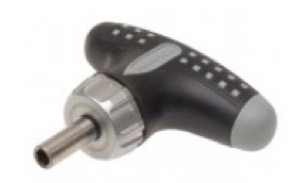
T handles are easy to hold when using a ratchet screwdriver
Ratchet Screwdriver Kits
Ratchet screwdrivers are available in slot, Phillips, and Pozidriv heads. They often come in kits with a ratchet bit holder and various bits.
While bit holders with multiple bits are handy, investing in a kit with a durable case is crucial. A strong case helps keep bits organised and prevents loss, which is essential for maintaining the kit’s usefulness.

Get plenty of screwdriver bits when buying ratchet screwdriver kits
Offset Ratchet Screwdrivers
An offset ratchet screwdriver features a ratchet mechanism where screwdriver bits are inserted at a right angle to the handle. This design allows the bit to fit into tight spaces more easily than a traditional screwdriver.
Using an offset ratchet screwdriver makes it easier to drive or remove screws in confined areas, providing better access and manoeuvrability.

Offset ratchet screwdrivers help fixing in tight places
Stubby Screwdrivers
Stubby screwdrivers are compact versions of regular screwdrivers. Their short length makes them ideal for tight spaces, like between kitchen units and walls. They’re also effective for loosening tight screws because the short handle allows for better torque and control, especially if you have strong hands.

A good grip is essential with a stubby screwdriver
Ratchet Stubby Screwdrivers
Ratchet stubby screwdrivers are essential for kitchen fitters, offering excellent manoeuvrability in tight spaces.
Similar to traditional ratchet screwdrivers, these tools often have bits stored in the handle, making them highly versatile and convenient.
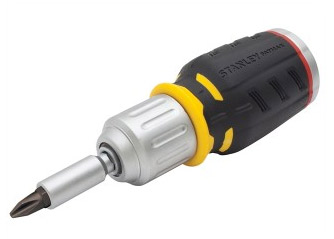
Stubby ratchet screwdrivers are ideal for tight working spaces
Nut Drivers (Nut Spinner Screwdrivers)
A nut driver, or nut spinner, is a specialised tool for loosening or tightening nuts and bolts. It features a cylindrical shaft with a socket that fits over the nut or bolt, working similarly to a traditional screwdriver or wrench.
Nut drivers come in fixed sizes with hollow shafts to accommodate long threads, or in sets with a socket holder that allows you to attach different sockets as needed.
When purchasing a kit, choose one with a durable case to prevent losing sockets, which can make the kit less effective.

Nut drivers give easy access when spanners will not fit
Insulated (VDE) Screwdrivers
Insulated screwdrivers are essential for working with or near electrical systems. Often referred to as VDE screwdrivers, the term comes from the German Association of Electrical Engineers (Verband Der Elektrotechnik), ensuring safety with electrical work.

1500Volts is a good safety barrier for an electrical or VDE screwdriver
Precision Screwdrivers
Precision screwdrivers have thin bodies and usually feature a rotating cap at the end. This design lets you hold the driver in your palm while twisting the shaft with your fingers. Ideal for small screws in items like batteries, having a precision screwdriver set is a must for detailed work.

Precision screwdrivers sets need to have both slotted and Phillips heads
Instrument Screwdrivers with Bit Holder
Instrument screwdrivers come with various bits, similar to screwdriver bit sets, but are much smaller. Bits are often stored inside the driver for convenience and safety.
Many of these drivers feature a pen clip on the body, making it easy to secure them in your pocket, especially the top pocket of overalls, while working in the workshop.

Keep instrument screwdriver bits safe using a pen clip for your pocket
Mains Testing Screwdrivers
Mains testing screwdrivers are used to check if an electrical circuit is live. They work by allowing current to pass through a resistor, reducing it to a safe level. You complete the circuit by touching the brass cap, which activates a neon light to indicate power.
While they can malfunction or become damaged if dropped in water, and should be used with caution, they are a valuable tool for quickly verifying if an electrical circuit is live.

Use mains testing screwdrivers safely
Torque Screwdrivers
Torque refers to the rotational force applied by tools like screwdrivers, spanners, or steering wheels. Each object has a limit called the yield point, beyond which it can break or deform if too much torque is applied.
Torque values for various materials and objects are recorded in reference tables, such as those used by garages for setting wheel nut tightness on cars.
Torque screwdrivers measure and control this force. They include a gauge or a preset mechanism that stops applying torque once the desired level is reached, preventing damage by ensuring you don’t exceed the yield point.

Torque screwdrivers allow the setting of certain levels of torque to prevent damage
Torx Screwdrivers
Torx screwdrivers are named after “torque”, as they are designed to apply maximum torque. Their distinctive star-shaped pattern provides a larger contact area with the screw or bolt, reducing the risk of slipping or breaking.
Combining features of Phillips, Pozidriv, and Hex screwdrivers, Torx drivers offer superior grip and control. They are available individually or more commonly in sets, as shown below.

Greater torque can be applied with a Torx bit
Torx Kits and Keys
Ryobi offers affordable Torx kits that meet professional standards. Look for strong, snug-fitting splines that ensure a secure grip and high torque. A durable case is essential for keeping your tools organized. The Ryobi kit, pictured below, includes a bit holder for added convenience.

Strong Torx bits and bit holder coming from Ryobi
Torx Screws
Torx screws are available in various lengths, including 30mm, as shown in the image. The image demonstrates the distinctive head shape of Torx screws. With the right Torx bit or key, these screws offer a secure fit, minimising the risk of slipping or breaking and allowing for high torque application.

Torx Screws are very strong with a large surface area in the Torx slot
Torx Keys
Similar to Hex keys, Torx keys provide greater leverage than Torx screwdrivers. Torx key sets are often designed to prevent loss of individual keys. For example, the Stanley Fatmax Torx Set features a folding design, neatly storing all keys in the handle for easy organisation.

The strong Stanley hex key set with bit lock to prevent sliping
Chisel Screwdrivers (Chisel Drivers)
Many DIYers and professionals use screwdrivers and chisels interchangeably for tasks like opening paint cans or removing paint from screws. However, using tools for unintended purposes can reduce their lifespan.
Chisel drivers are designed for more demanding tasks. They feature a stronger tip and a handle securely attached to the shaft, making them durable and ideal for heavy-duty use when extra robustness is needed.
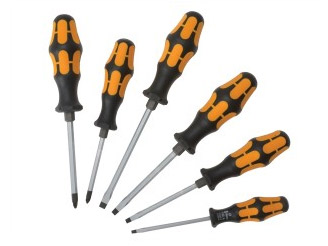
Chisel Screwdrivers…The link between screwdrivers and chisels
Demolition Screwdrivers
Demolition screwdrivers are designed for heavy-duty tasks. They feature a metal cap on the handle that connects directly to the shaft, allowing force to be transferred efficiently to the tip. This design makes them suitable for tasks like prying and hammering.
The shafts are reinforced for added strength and often include a cushioned grip to reduce hand vibration during use.

A Demolition Screwdriver takes the force of a blow directly to the tip
Hex or Bolster Screwdrivers
Hex or bolster screwdrivers feature a hexagonal nut welded to the top of the shaft. This design allows you to apply extra pressure using a spanner if the screw is tightly stuck.
These screwdrivers are often confused with demolition screwdrivers due to the term “bolster”. However, “bolster” here refers to the added support from the hex nut, not to be confused with a bolster chisel. The video below demonstrates this tool’s functionality.

Bolster screwdrivers can be used give added torque by using a spanner to turn the shaft
Storing Screwdrivers and Screws
Using the wrong screwdriver size or type can damage screws, furniture, or your project, leading to frustration and extra costs. Proper tool storage prevents these issues by ensuring you can easily find the right tool when needed.
Effective storage doesn’t have to be expensive or complicated. Affordable solutions from companies like Faithfull Tools make it simple to organize your tools and fixings. The image below showcases a budget-friendly storage option that offers great value.
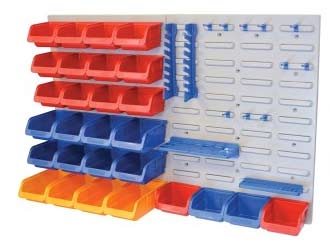
Faithfull tools, tool, bits, screws and bolts storage solution
The list above shows various screwdriver types, each designed for specific screws or situations. With so many options, choosing the right one can be confusing. However, the information provided will help you select the best screwdriver for your needs.

